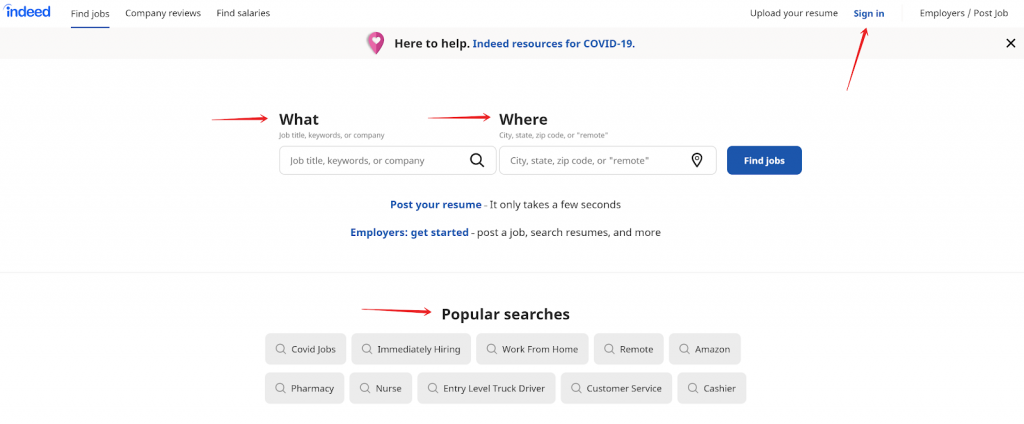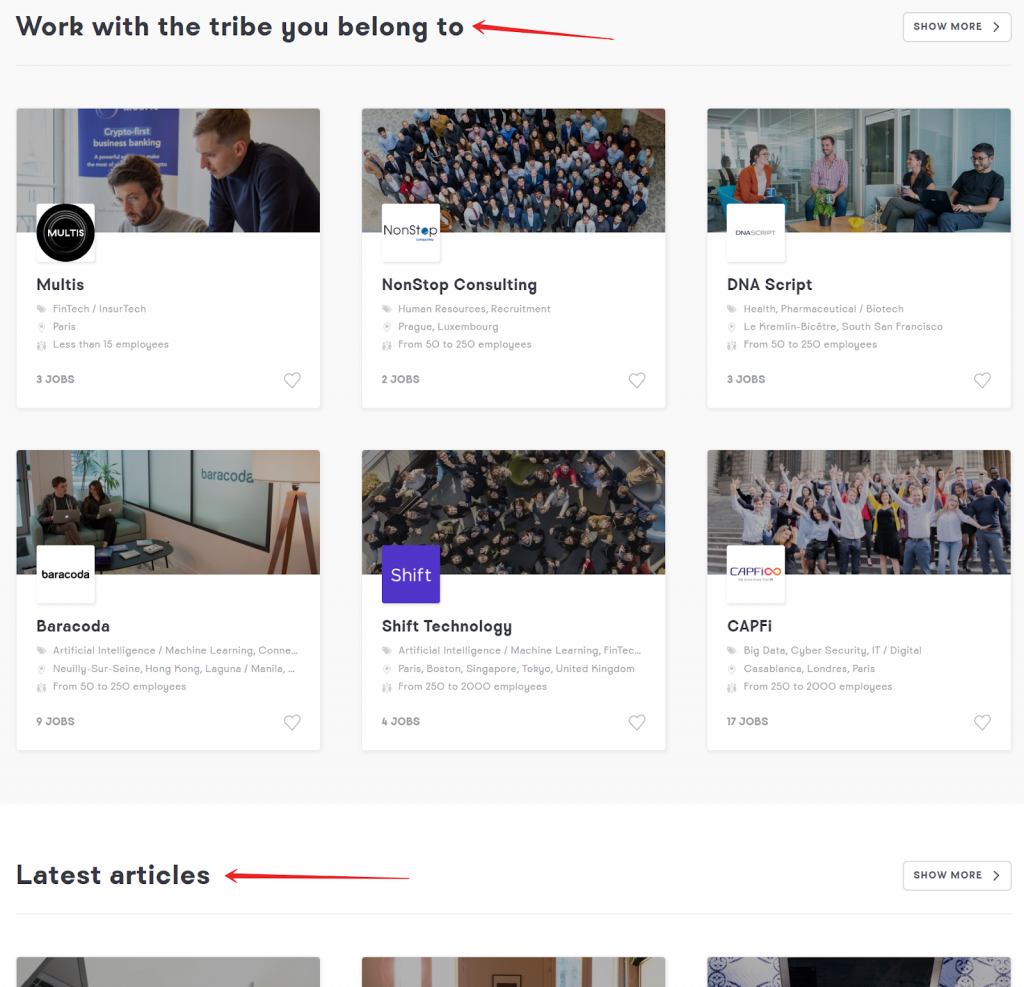How to do SEO for recruitment sites
Since LinkedIn has emerged more prominently, the process of hiring employees and posting jobs has evolved.
LinkedIn has made things much easier for users, but on the other hand it has made it more complicated for pure job posting companies.
That’s why to complement your strategy against this social network it’s important that you use alternative recruitment methods.
And one method that you can count on from minute zero is SEO!
In this guide we will approach the essential technical recommendations to make your site work and get traffic through the search engines.
Here we go!
Investigate your rivals
This is one of the key starting points, not only in this sector, but in any search engine positioning strategy.
Homepage analysis
To begin with, analyze how the home page works and which pages it gives relevance to within the website.
Remember that everything that is usually shown on the homepage is there because it is core business. This gives you clues as to where to start.

In this snapshot of Indeed, we clearly see a separate search engine by type of job / sector / company and where to work.
We also see a list of popular searches from which we can get ideas of what users are most looking for, which we can use to create either categories or related content on our blog.

Infojobs, a well-known job posting website in Spain, separates their site into three sections: by type of job, by workplace and by sector at a generic level.
With a quick glance we can already start to assemble something in our head of how to organize our own content.

Welcometothejungle, for example, prioritizes companies and blog posts, as its strategy is slightly different from traditional ones.
It focuses more on a consideration of possible jobs even before a person is actively seeking them.
Google searches with the site:website.com command
Another trick is to use the site:website.com command in Google.
By looking at the SERP results, you can see how they generate the titles and descriptions to find patterns easily.
At this point I would tell you to review as many sites as possible within your sector and identify common patterns for use on your site.
Diving deeper
Using tools such as Ahrefs you can also do a more in-depth analysis of what is working for rival sites.

Organize your website
Within the site sections where jobs are posted, choosing the right web architecture is paramount, to both the user experience, in finding related content, and to Google, in crawling the most important pages on the website and recognizing well how it is structured.
Having this in place allows for good scalability and almost-automatic URL handling if jobs are posted on a daily basis.
To make this architecture efficient we can think about the typologies of the searches that users make, and then segment them.
In this way, and thanks to the analysis of the rivals we carried out earlier, we can get these four segments:
- Work by sector (Marketing, Commerce)
- Working in a city (Paris, New York)
- Working in a company (Stripe, Zara)
- Work by job title (SEO Manager, Dependent)
We must identify which content can work well as a category and which other content we can use as facets when filtering the content.
To implement this correctly, we must perform a study of keywords and then make a mixture of all of them and thus be able to have long tail searches of this style: SEO Manager at Stripe or Salesperson at Zara in Barcelona.
Mindmapping software like Xmind will allow us to map the architecture in a visual and more easy-to-understand way.
How to create the categories?
Once you have decided how to structure the content, you have to focus on the categories, since just like in ecommerce, they will be the places where you receive the most traffic.
The types of jobs can be in different categories: Nursing Assistant in Paris can be found in Jobs in Paris and in Medical or Nursing Jobs for example.
The categories will be the places through which you will attract traffic in quantity, particularly if you have validated your category choices with a previous keyword study.
How to create the job pages?
Job offers are like products: you must automate as much as your work on them as possible, especially if they are published in large numbers on your site.
Job pages will correspond to the long tail searches on your website, so first study how to organize the prominent parts of the content such as the Title, a friendly URL, the description, the H1 and structured data.
Interlinking and authority
It is important that the website is easily accessible to users and also that the PageRank is distributed in a uniform way, prioritizing the upper layers that we have catalogued as the main ones.
The home page will be your starting point and the most powerful page on the site, so use it as a way to promote internal parts of the website that are not easily accessible or to publish new jobs so that Google can access them quickly.
Remember that you must make the user experience agile and ensure that Google understands the architecture well. This is achieved through good internal linking.
Using breadcrumbs and specific data markup will help a lot if we have a clear architecture from the beginning.
The main navigation menu is also a place you need to work on strategically.
Have a blog
In this sector this is almost non-negotiable when you start, since it will allow you to find users in the different stages of a job search, not only active job seekers.
Effective categorization of the content that we will publish is key, since we will be able to offer interesting resources, even to people who are not even considering changing jobs at the moment. When they begin to consider a change, however, your website will be on the top of their mind.
User or customer pages
This aspect is interesting, since we will be able to round off our effort to attract people through SEO if we are able to get them to contact us or create a user profile for themselves.
You can use several strategies. One effective strategy is to make the potential user see the advantages of being part of your community and offer an important resource in exchange for being part of it.
Attracting traffic is good, but getting them to stay with your brand in some way is the best.
Structured data
This option will allow you to have an extra boost when appearing in the search engines.

Google has been allowing this specific market for some time, so you should take advantage of it if it is available in your location.
Here you have all the information about how to implement job-posting structured data.
Offers that have expired or have already been filled
Finally, let’s talk about what we can do when a job offer has been filled or is no longer available.
As we have said, these pages are like products but they are usually volatile, as the idea is that opportunities are only filled once.
We have several options depending on the type of website we work with, but the ideal is to use what you consider optimal depending on the size of your website:
- Leave the offer active even though it is no longer available but automatically provide links to other similar ones if you have them.
- Turn the offer off immediately and remove it from the web, leaving it with a 404.
- Redirect expired offers to other similar ones or to the main category that makes the most sense.
TL;DR
If you want to go straight to the point, here’s a summary:
- Spy on your rivals by analyzing their home page and their calls to action, using tools like SEMrush or Ahrefs to see where they concentrate their traffic.
- Plan the web architecture based on content clusters after an analysis of competitors and make sure they fit with the offer you have. The categories will be the places where the volume of traffic is concentrated and the offers will address the long tail of your website.
- Use internal linking to prioritize the top and most important layers and link from the home page to important pages such as new offers or to pages with high conversion rates.
- Have a blog so you can find potential clients before they even consider changing jobs. Useful and quality content will make users remember you.
- Retain users by getting an email or contact information. Attracting users is fine but it’s better to keep some form of contact with them.
- Metadata will help Google to understand your website better and to give you the possibility to be featured in specific pages for job offers within the SERPs.
- Understand how best to manage expired offers. They are like products in ecommerce with the exception that there is usually only one unit available.
Job posting sites are very competitive. On one hand, this is because they can move large amounts of traffic, and on the other hand, because the users who enter them are actively seeking to engage with the offer on the site that attracted them.
Having an understanding of how to arrange content and especially how users find it is key to making sites like these work properly.

